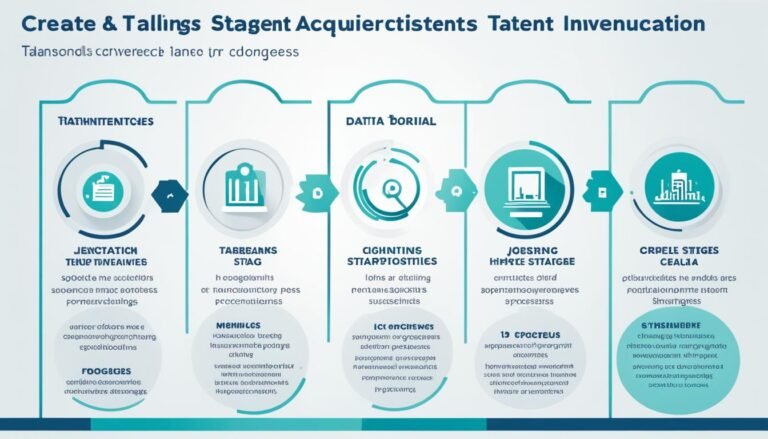Leadership Feedback: Fostering Growth
“Feedback is the breakfast of champions.” – Ken Blanchard
Feedback in leadership is more than sharing thoughts. It’s a tool for growth. Leaders who welcome feedback see big changes in their groups. They create a space for everyone to get better.
In this piece, we explore how feedback powers growth. We’ll look at giving insights right away and keeping talks private. Knowing these tips will help us all change for the better.
Now, let’s jump into the world of leadership feedback. Let’s see how it opens doors for growth in people, teams, and companies.
Key Takeaways:
- Feedback is essential for fostering growth and development in organizations.
- Effective leadership feedback plays a central role in shaping better leaders and building competencies.
- Feedback should be provided immediately after an action or event to maximize its impact.
- Confidentiality is crucial when giving feedback to ensure dignity, respect, and a meaningful exchange.
- Preparing recipients for feedback promotes a collaborative problem-solving mindset.
The Silent Gap in Leadership
Feedback in leadership often falls short, creating what’s known as the silent gap. This is when necessary feedback doesn’t happen if expectations aren’t met. This missed chance for guidance can slow down growth for people and teams.
Feedback is key for progress and learning. Leaders need to use strong feedback methods to fill this silent gap. Understanding the value of feedback helps leaders build a culture of always getting better.
“Feedback is a powerful tool for leadership development. It helps individuals understand their strengths and identifies areas for growth.”
To break the silent gap, using the right feedback techniques is vital. Leaders should give useful feedback promptly. This helps their team improve in both personal and work aspects.
Here are some proven tips and methods for giving good feedback:
| Feedback Strategies | Leadership Feedback Best Practices |
|---|---|
| Giving feedback to foster growth | Give clear, useful feedback on what needs to be better. Also, point out strengths. Help in their development. |
| Leadership feedback strategies | Use feedback that helps people grow. This includes making goals clear, listening well, and keeping talk honest. |
Following these strategies and practices will help close the silent gap. It makes growth, learning, and open talking important in the workplace.
Transforming Challenges into Opportunities
Fixing the silent gap changes things for the better. Leaders need to see why feedback is so important. They should aim for growth and talk with their teams a lot. This way, they set up a place where getting better and succeeding is normal.
The Immediacy of Insight
Feedback is key for leaders aiming to nurture growth and advance skills. Yet, its timing is vital. Right after an event or action, feedback’s weight is immense. It brings clarity and learning immediately.
Prompt feedback lets people tie their actions to results and behaviors. This quick link boosts learning and drives home the lesson. Be it praise for success or addressing a shortcoming, immediate feedback helps leaders give guidance in real time. It shows people exactly how their actions affect others.
“Immediate feedback provides leaders with the opportunity to guide and shape behaviors in real-time, increasing the chances of course correction and sustained growth.” – Leadership Expert
Instant feedback also stops problems from piling up. Early problem tackling means they’re solved fast, reducing chances of them coming back. This approach fosters a growth and betterment culture. By giving feedback right away, leaders prove they’re dedicated to everyone’s personal success.
*Image description: A visual depiction of a leader giving immediate feedback to a team member, symbolizing growth and communication.
Feedback Techniques for Growth
To make feedback really work, choosing the right techniques is key. Here’s how leaders can do it:
- Constructive Criticism: Point out areas for growth with helpful suggestions.
- Specificity: Be clear in what needs to improve.
- Empathy: Think about how feedback affects the person emotionally.
- Active Listening: Listen to the person to build trust.
- Goal-Setting: Help set achievable goals for improvement.
Mixing immediate feedback with these methods builds a feedback environment that spurs betterment. It helps everyone reach their highest potential.
| Immediate Feedback Benefits | Effective Feedback for Leaders |
|---|---|
| Promotes immediate learning and course correction | Encourages growth and development |
| Prevents recurring issues and addresses them promptly | Enhances individual performance and productivity |
| Builds trust and creates a supportive feedback culture | Strengthens relationships and fosters team collaboration |
| Encourages open communication and dialogue | Improves leadership effectiveness and decision-making |
The Sanctuary of Privacy
Feedback in leadership is crucial, and keeping it private is key. This private nature of feedback chats is super important. It helps grow and keep trust strong in groups. If feedback is public, it can harm relationships and work quality. So, it’s best for leaders to give helpful feedback in private. That way, people can really think about what they’ve heard and react respectfully.
Making feedback private makes a safe space. In this space, people feel protected and respected when sharing. They know they won’t be judged or face bad outcomes. Leaders can then help improve areas with kindness. This keeps the dignity of the person getting the feedback.
“Private feedback allows for a more meaningful exchange, facilitating a deeper understanding of one another’s perspectives and fostering a sense of respect and trust. It creates a safe space for growth and development.”
Speaking to team members one-on-one helps leaders understand their needs better. This approach lets leaders give feedback that’s just right for each person. This supports the growth of everyone on the team.
Private feedback also makes it easier to talk about tough stuff. Performance issues can be brought up without fear in private. It’s less embarrassing than in front of others. This way, leaders and their teams can fix problems together.
Private feedback does more than just keep things confidential. It also shows how listening and talking are important. Making a safe space gets everyone to speak up. This helps build a culture where feedback is valued and respected by all.
Benefits of Private Feedback:
- Preserves the dignity of individuals receiving feedback.
- Allows for personalized feedback tailored to individual needs.
- Fosters open and honest communication.
- Enables candid conversations about sensitive topics.
- Promotes a healthy feedback culture.
Choosing private feedback shapes a culture of trust and growth. Leaders who keep feedback private show they care about team development. They build an area where talking openly and growing personally is important.
The Heads-Up: Anticipation without Anxiety
Preparation and anticipation are key for good feedback in leadership. They help grow and create a team spirit. A heads-up before feedback can make the talk less defensive. It promotes solving issues together.
Giving background with a video or message is a smart step. It gets the person ready for feedback by explaining its goal and what’s expected. This way, the talk can be more open and positive.
“Feedback is the breakfast of champions.” – Ken Blanchard
For advice on how to improve, a heads-up really shines. It makes the space safe, so individuals can reflect. They become more aware of their own growth areas.
This method cuts down on fear and defensiveness. It makes talks about getting better and understanding each other easier. People are more likely to work on their skills with this support. Leaders can give good advice without causing stress or bad feelings.
Sample Heads-Up Message:
Subject: Feedback Session – Upcoming Growth Discussion
Hi [Employee’s Name],
I hope you’re doing well. We have a feedback session set for next week. It’s to chat about your recent project and how you’re doing as a leader.
The goal is to give you tips that focus on your strengths. We also want to help you see where you can become an even better leader. This talk will guide your path to getting better and growing professionally.
Think about your journey as a leader and any big wins or challenges. We want to talk about these during our meeting. This time is a chance to improve and move past any tough spots.
Thanks for being so dedicated. Looking forward to our chat and helping you become an even stronger leader.
The Specifics that Speak Volumes
Ambiguous feedback doesn’t help anyone get better. When talking to leaders, be specific. It helps them understand what to focus on for growth. General comments or feelings without examples miss the mark. They don’t fix the real issues.
Specific feedback lets leaders really look at their strong and weak points. This way, they can find and work on what they need to improve. Knowing exactly what actions or behaviors help or hurt them is key. It means they can get better at what they do.
“Feedback is the breakfast of champions.” – Ken Blanchard
Clear feedback is like a map for leaders to grow. It shows how they affect others and helps them adjust their style as needed. This kind of feedback also pushes everyone to always get better. It makes sure people aim for their best all the time.
Consider this example to see why specific feedback is important:
| Generic Feedback | Specific Feedback |
|---|---|
| “You need to improve your communication skills.” | “When presenting to the team, focus on providing more concise and organized information. Use visual aids to enhance understanding and engage your audience.” |
Think about generic versus specific feedback. The first doesn’t really say much. The second gives direct tips to get better at communication. It pinpoints what needs to change and how to do it.
Specific feedback can help leaders do more than expected. It lets them grow as leaders and motivate their teams for success. Making feedback detailed opens the door for big growth in leaders and their teams.
Key Takeaways:
- Ambiguous feedback hinders improvement.
- Specificity in feedback is key to helping leaders grow.
- Leaders must dig into vague feelings to find the real issue.
- Specific feedback helps leaders spot and work on issues.
- It promotes a working culture where everyone wants to do better.
- Clear feedback gives leaders clear steps to boost their job.
Next, we’ll talk about how looking at feedback can help leaders learn about themselves and get better.
Reflection: The Mirror for Leaders
Leaders who want to keep growing need to look at themselves closely. This means thinking about how they lead and getting feedback. Reflecting helps them see where they can do better and understand themselves.
When leaders think deeply, they see their part in any problems. They notice where they need to grow. This makes their leadership more real and trustworthy.
This thinking helps leaders see how they affect others and the company. It guides them to act in ways that match their goals. This makes them better leaders.
“Reflection is the lamp that illuminates the path to growth and self-awareness. It empowers leaders to take ownership of their development and make meaningful changes.”
Leaders who reflect often are better at fixing their weak spots. They understand themselves and their team more. This creates a good change in the whole organization.
Embracing a Reflective Practice
To be good at reflecting, leaders can do a few things:
- Make time every day or week just for thinking.
- Write down what they think and how they feel to understand better.
- Ask for advice from people they trust, like mentors and team members.
- Use hard feedback to improve themselves.
With reflection, leaders get to know themselves better. They grow in their work and personal life. This makes them more successful leaders.
Constructive Feedback: A Two-Way Street
Feedback is key for growth in leadership. It’s not just one person talking. It’s a back-and-forth between leaders and their team members. This creates a culture of feedback that welcomes everyone’s thoughts.
Both leaders and team members share ideas through feedback. This lets everyone have a say. It helps everyone feel they are working together towards success.
Gathering feedback helps identify areas to grow. Leaders learn from their team’s feedback. This leads to continuous improvement for all.
“Inclusive feedback is a powerful tool for leaders to understand and address the needs of their team members. By actively seeking input and listening to diverse perspectives, leaders can build trust, foster engagement, and create a culture of growth and development.” – Jane Smith, HR Director
Using inclusive feedback shows effective leadership. It means leaders consider different ideas, admit their mistakes, and involve the team in decisions. This approach strengthens the team and the work environment.
Benefits of Two-Way Feedback:
- Enhances mutual understanding and trust between leaders and team members
- Provides a platform for team members to contribute to leadership development
- Promotes a culture of ownership, accountability, and continuous learning
- Fosters open and transparent communication
- Informs leaders about team members’ needs, aspirations, and concerns

Two-way feedback, along with inclusive practices, supports teamwork and growth. It’s a foundation for strong leadership. Such practices lead to success for leaders and their teams.
| Leadership Feedback Practices | Description |
|---|---|
| Encourage open dialogue | Promote regular communication channels for feedback sharing |
| Actively listen | Show genuine interest in feedback and validate team members’ perspectives |
| Respond with empathy | Consider the impact of feedback and respond compassionately |
| Provide constructive feedback | Offer specific, actionable feedback that focuses on growth and development |
| Recognize and appreciate | Acknowledge achievements, efforts, and contributions |
Leadership feedback is more than just a one-way conversation. By embracing a two-way feedback approach, leaders cultivate an environment of inclusivity, collaboration, and continuous development. This fosters individual and team growth, propelling organizations to success.
The Positive Reinforcement
It’s vital to highlight success, not just flaws. Positive feedback lifts spirits, praises work, and inspires more. By mixing in some cheers with advice, teams are motivated to aim higher.
“Recognition is the greatest motivator.” – Gary Chapman
Recognition in leadership feedback is a mighty lever. It shows team efforts are valued. With specific and authentic praise, team morale and success rise.
Praise pushes people to maintain good work. It cements behaviors that help meet goals. Acknowledging team wins boosts a culture of growth and excellence.
Leadership feedback best practices require specific and heartfelt thanks. Noticing the special skills of each member fuels their drive. Timely cheering on for positive steps keeps everyone happy and engaged.
Sharing wins openly is a smart move. It can be in meetings, newsletters, or online. This spreads joy, strengthens teamwork, and sets examples to follow.
The Power of Recognition
Positive feedback boosts confidence and loyalty. Leaders showing appreciation make a workplace that sparks everyone’s best efforts.
Through recognition, leaders guide their teams to outperform. A recognition-rich culture lifts everyone, making a better workplace and better results.
The Follow-Through
Feedback is key for continuous growth, not just a one-time thing. It’s a loop that helps leaders develop and improves teams. With steady follow-up, leaders show they’re serious about growing themselves and others. This support keeps feedback important and fresh in everyone’s mind.
This loop lets leaders talk about progress and solve challenges. They also get to cheer for wins and offer advice. By talking regularly, they build trust and teamwork.
Good leaders always look for feedback, from inside and outside their team. This gives them new views and helps them know themselves better. They always aim to get better, keeping their eyes on growth.
Benefits of a Continuous Feedback Process
A feedback culture helps with lots of things:
- Better self-understanding
- Higher performance and taking responsibility
- More satisfied and engaged teams
- Stronger team connections and trust
- A workplace that loves to learn
Using feedback the right way helps leaders and their teams grow. This growth leads to success and new ideas in their company.
Implementing a Continuous Feedback Process
For a good feedback system, leaders should:
- Explain clearly what you want from feedback. Make sure everyone gets why it’s important.
- Make a place where it’s safe to share thoughts. Everyone should feel they can talk freely.
- Tell people often how they’re doing, what they’re good at, and where they can do better.
- Ask people to think about their actions and what they’ve learned. This helps them grow themselves.
- Give help and tools to improve. Offer guidance and chances to learn new skills.
- Urge people to ask for advice from coworkers or mentors. This gives them fresh, useful views.
- Keep track of how everyone’s doing and keep helping them get better.
Doing these steps often builds a place where feedback is natural. This leads to better leadership, team growth, and a love for always learning.
Conclusion
Leadership feedback is a key for better leaders and personal growth. Successful strategies include quick feedback, privacy, being specific, and looking back. You also need to talk both ways and give praise, not just pointing out mistakes.
Giving feedback right away helps people see what they need to work on. Keeping it private and positive makes learning more respectful and effective. Details in feedback show exactly what you need to do to get better.
Thinking about your role in problems makes you wiser and real. Open talks lead to a feedback that everyone can learn from. Mixing advice with praise makes the good work stand out more, boosting morale.
Mastering leadership feedback is crucial. These methods can build a team that’s always growing. This leads to success in both work and life.
FAQ
Why is leadership feedback important for fostering growth?
Leadership feedback is vital for making better leaders and improving skills. It helps grow and develop people in companies.
What is the silent gap in leadership feedback?
The silent gap is when feedback is missing after not meeting expectations. This gap stops people from growing and getting better.
Why is timely feedback important?
Timely feedback provides clear explanations and quick learning opportunities. This makes feedback more effective for growth. Delaying feedback weakens its impact.
Why is confidentiality crucial in giving feedback?
Being confidential keeps feedback respectful and meaningful. It ensures private, constructive discussions for improvement.
How does providing a heads-up or prelude to feedback impact the conversation?
Introducing feedback with a video or message helps recipients be ready. This makes them less defensive and more ready to solve problems together, which helps everyone grow.
Why is specificity in feedback important?
Specific feedback guides leaders clearly. It helps them understand what to work on. This reflection leads to real improvement.
Why is introspection vital for leadership growth?
Looking inward helps leaders connect feedback to their actions. It makes them aware of their faults, improving their leadership with honesty.
Why should feedback be seen as a dialogue?
Making feedback a two-way conversation encourages learning, responsibility, and growth. It ensures a full, effective developmental process.
Why is it important to acknowledge success in feedback?
Recognizing success boosts team spirit and motivates further achievement. It builds a culture of appreciation and hard work.
How does follow-up reinforce the feedback message?
Following up shows a commitment to help and support ongoing development. It keeps the focus on growth, benefiting the whole team.








